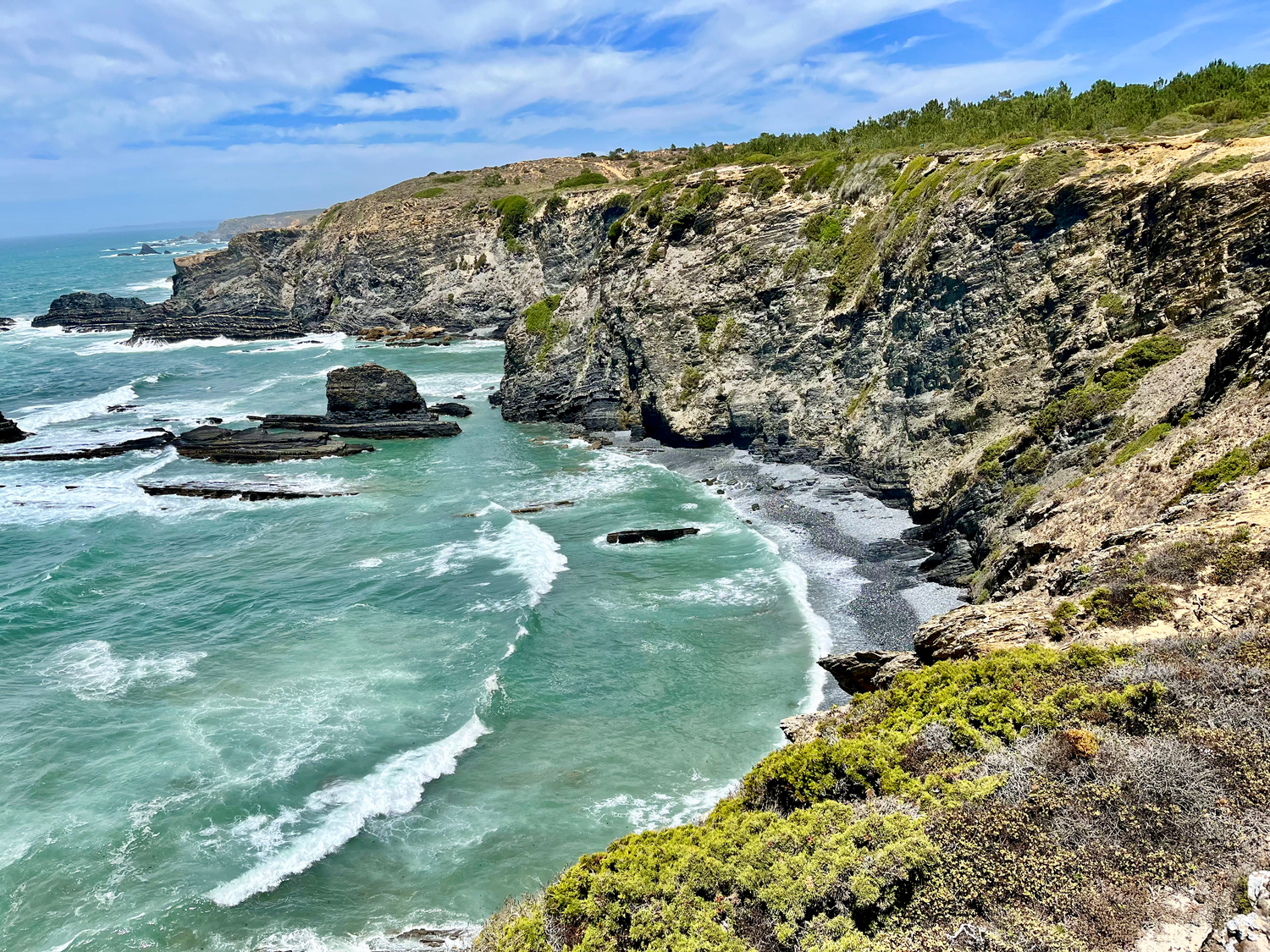
Fisherman's Trail
Feet buried deep in the loose sand. Your skin is dirty from the salt, a fine mixture from the ocean and your sweat. The sun is burning, making the sand almost to hot too touch, yet the ocean breeze is making the climb up the cliff manageable. Thank god for the wind. You are surrounded by the sounds of the ocean birds and the waves crashing against the cliffs. The view stops you in your tracks: the cliffs spilling into an untouched beach, the ocean stretching out forever. Soon, you’ll be down there, feet in the surf, letting the cold water wash away the heat. This is The Fisherman’s Trail.
The first steps
When I first read an article about the Fisherman’s Trail, describing its mix of rugged cliffs and stunning ocean views, I knew I had to walk it. It was my favorite combination: cliffs next to the ocean. The Fisherman’s Trail, part of the Rota Vicentina network, is a multi-day hike often considered as one of the most beautiful coastal trails in the world . With the length of 226 kilometers, it takes about 11 to 13 days to complete, starting in São Torpez and ending in Lagos.
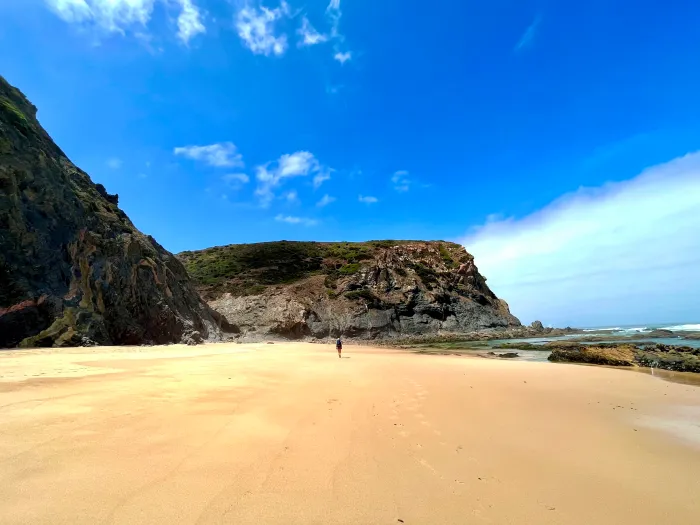
In 2022, we had never attempted a multi-day hike. The Fisherman’s Trail would be our first, and its manageable distance and elevation felt like the perfect way to begin. The only hitch? We planned to walk it at the end of June and into July, a time when most advice suggests avoiding the trail due to the heat and crowds. But, naive as we sometimes are, we figured we could handle it.
After spending a few fun days sightseeing in Lisbon, we boarded a bus at Lisboa (Sete Rios) to Porto Covo. The trail officially begins in São Torpez, but with no active bus station there, starting in Porto Covo made the most sense. Packed with full backpacks and camping gear, we arrived just in time to catch a beautiful sunset, enjoy a nice dinner, and get a good night’s sleep at the campsite. By morning, we were more than ready to begin.
Into the Sand
The first day of hiking to Vila Nova de Milfontes (19.5 km) hit us hard. The trail is marked as “difficult,” but we’d seen “difficult” trails before and figured it couldn’t be that bad. We were wrong. On the Fisherman’s Trail, difficult actually means difficult. Around 60–70% of the route is on loose sand, and hiking with your ankles sinking into the sand is no joke.
It wasn’t easy, but it was worth it. The views were incredible—wild cliffs and a restless ocean due to the wind. Exhausted but exhilarated, we reached Vila Nova de Milfontes by the end of the day, ready to rest up for what was ahead.
The next day’s hike to Almograve was shorter—just over 13 km—but that didn’t make it a breeze. It’s one of the shortest sections of the Fisherman’s Trail and the shortest stretch on our route to Sagres, but it’s still marked as “moderate.” More sand awaited us, along with remote beaches that made the effort worth it. By midday, the cold ocean was irresistible, and I couldn’t help but take a refreshing dip in the waves.
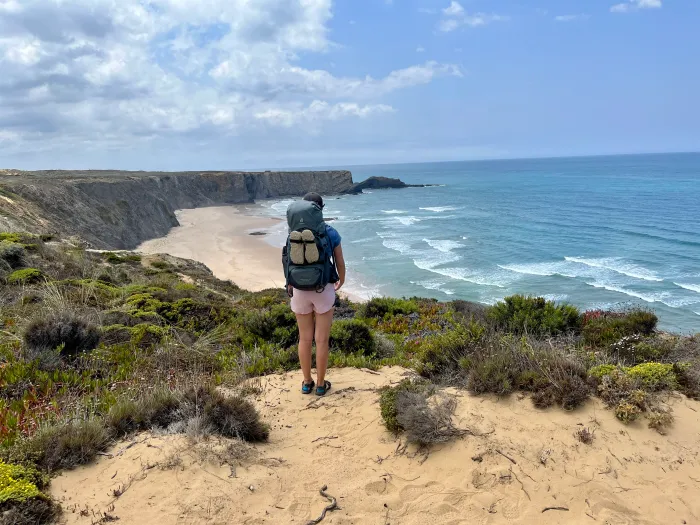
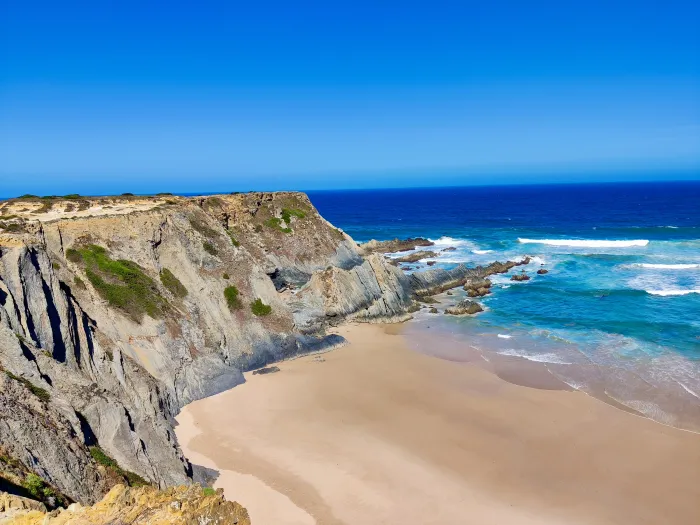
Onto the Cliffs
Starting in the harbor of Almograve, we began our 21.5 km hike to Zambujeira. Instead of following the official trail to a nearby bridge, we took a small shortcut—a ferry ride across the water. At the pier, a group of cats were laying in the sun as if they owned the place. We couldn’t resist stopping, to give them a few scratches and let them steal a moment of our attention. This day’s hike led us along endless desert-like roads, but the reward was incredible: sharp cliffs leading into the ocean with breathtaking views.
On the cliffs, we spotted storks, busy feeding their young in their nests. It is a great feeling to know that you can rest your feet and recharge at the end of every section in a charming, typical Portuguese, coastal village.
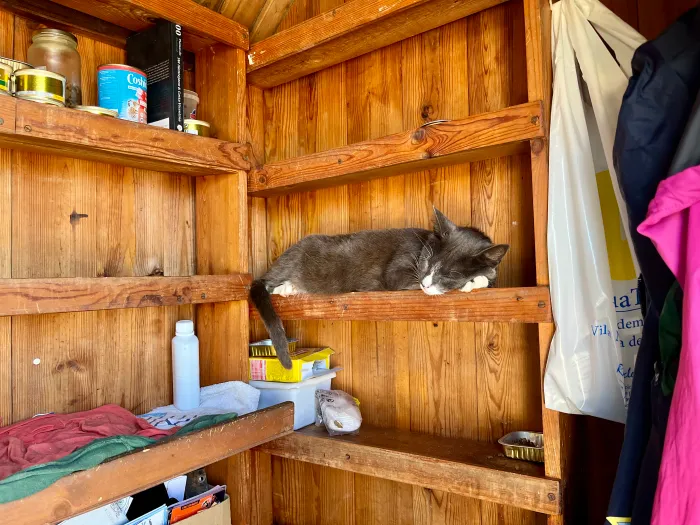
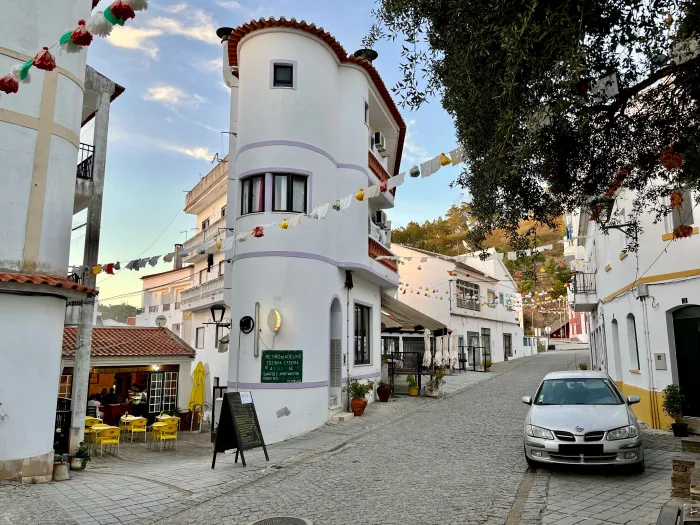
One of the highlights of mornings on the trail is starting the day in a local pastelaria. The coffee in Portugal is fantastic—and affordable—with espresso prices starting at just 1€. After a great breakfast and fully recharged, we set out for Odeceixe, a 21 km section that felt like one of the most rewarding yet.
This stretch of the trail winds up and down the cliffs, each ascent revealing untouched beaches and new, dramatic views on the other side. The sounds along the route were just as impressive as the scenery: seabirds calling overhead and waves crashing hard against the sharp cliffs below. Along the way, we noticed many of the hikers we’d met were finishing their journeys here in Odeceixe. They weren’t giving up—it was simply the original endpoint of the Fisherman’s Trail before the extension to Sagres was added.
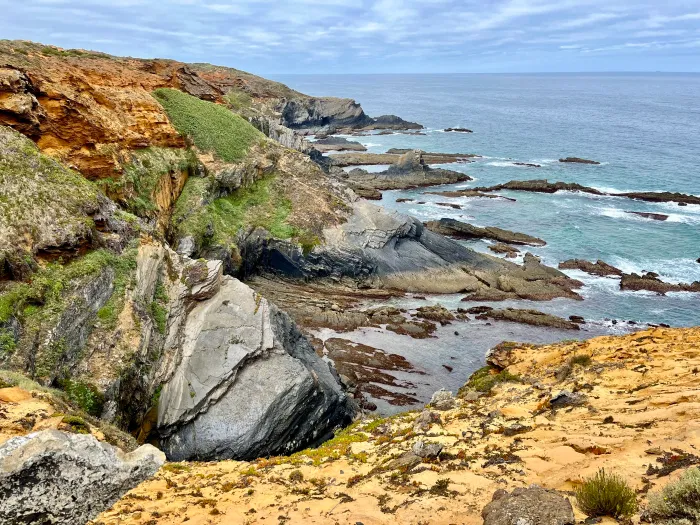
The Road Less Traveled
Putting on our shoes for the 23 km trail to Aljezur was becoming harder and harder. Sand in our shoes leaves traces of blisters. We started experimenting with hiking in our sandals during the sandy stretches, and while it eased the pressure on our blisters, the midday heat made the sand unbearable against our bare skin.
The thought of lying on the beach echoed in our minds
With most hikers stopping in Odeceixe, the first 11 km were a blast. The trail was quiet, and the breathtaking views of the untouched coastline were all ours. But as the trail moved inland, the scenery changed into dusty and endless desert roads. The ocean breeze, we so much loved, was nowhere to be found to cool us down under the burning sun. It was a challenge, not just physically, but mentally, too. The pain of our feet became more intense as there were less distractions, and the thought about us just lying on the beach, slowly draining our energy and spirits.
Then suddenly, a bird flying right above our heads snapped us back to reality, ready to attack us. It was protecting its nest and wasn’t about to back down. As hard as we could with our heavy backpacks, we ran to safety. As our adrenaline faded, the doubts crept back in. Was this why 80% of hikers stop in Odeceixe, as the locals say?
But after a good rest and some quality food in Aljezur, we felt ready to move on and forget yesterday’s struggles. Aljezur, like Odeceixe, sits slightly inland, but the trail leads us back to the coast. We set off for Arrifana, a 20 km stretch that we hoped would be more forgiving.
The hike started with long stretches next to dusty roads. But as we got closer to the coast, the sight of the ocean brightened our mood. Even the deep sand felt comforting—at least for a little while. It is our sixth day of continuous hiking and we really started to feel the soreness in our muscles. The last three kilometers to Arrifana were brutal. We kept thinking, we must be almost there, but the village refused to appear.
When we finally arrived, we were greeted by a hidden gem—a cozy retreat with a pool where we could completely relax. We forgot the soreness quickly, and for the first time in days, we felt truly refreshed.
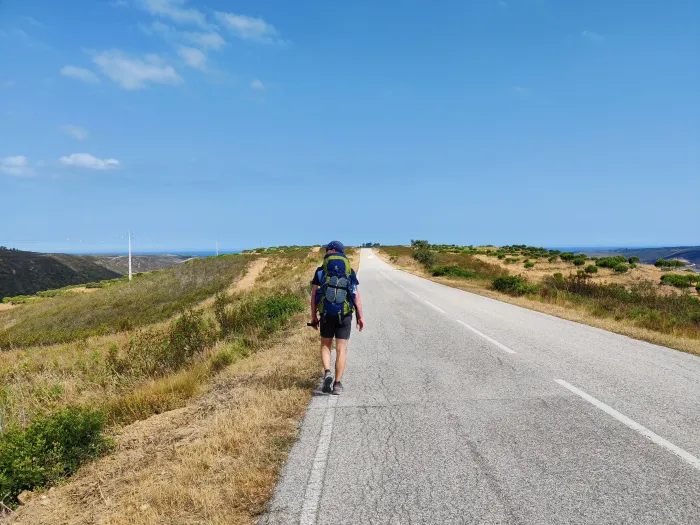
Off the beaten path
After recharging in Arrifana, we set out for Carrapateira, a 20.5 km hike. Looking at the map, we knew another long stretch on dirt roads awaited us. But along the way, we crossed an empty, pristine beach that was impossible to leave behind. Checking the tides and using satellite images of the trail ahead, we realized we had an opportunity: we could follow the coastline for this section, walking on the sand before the high tide rolled in.
We had never walked on a beach so remote, so untouched by humans. The sea mist rolled in, giving the place a magical, otherworldly vibe, yet feeling quiet nervous with no escape when the high tide sets in. When the beach ended near a surf spot, the cliffs took over, forcing us to reunite with the inland trail. Just as we prepared to tackle the dirt roads again, a kind couple with a beautiful dog offered us a ride down to the trailhead. We couldn’t believe our luck and the kindness of this beautiful family!
Reunited with the trail, we trekked through more deep sand, passing a lively surf beach before finally arriving at the charming village of Carrapateira. Grateful and exhausted, we knew that every challenge along the way had been worth it.
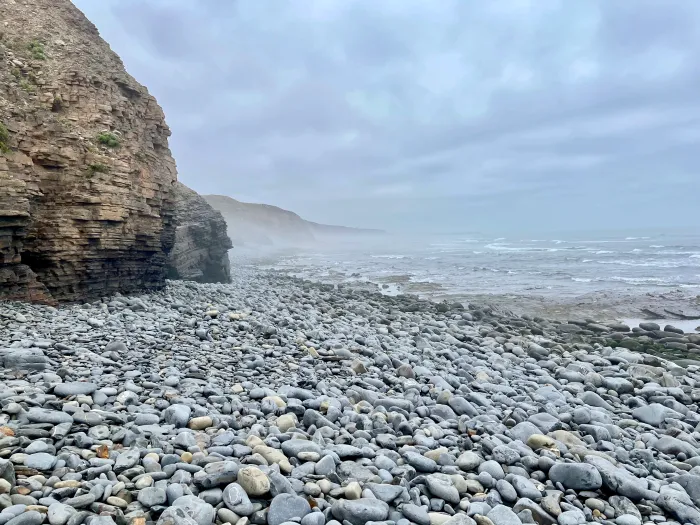
The last steps
We were heading to our second-to-last destination, Vila do Bispo, a 15.4 km hike. Today’s stretch offered some of the most breathtaking views we’d seen on the entire journey. The rock formations here were unlike anything we’d encountered before—rugged and colorful cliffs towering over untouched beaches. They reminded us of the dramatic landscapes we’d seen in photos of Iceland. Adding to the beauty were the wild rosemary bushes that grew along the trail, their scent stayed with us as we walked. Walking along the coast felt like coming home. We were so grateful that we had pushed through the doubts and negative thoughts earlier in the journey to experience this moment.
While this section was shorter than others, climbing the cliffs under the unforgiving midday sun with our heavy backpacks was anything but easy. Though our heartbeats pounded in our throats, their sound was lost in the waves crashing against the rocks below.
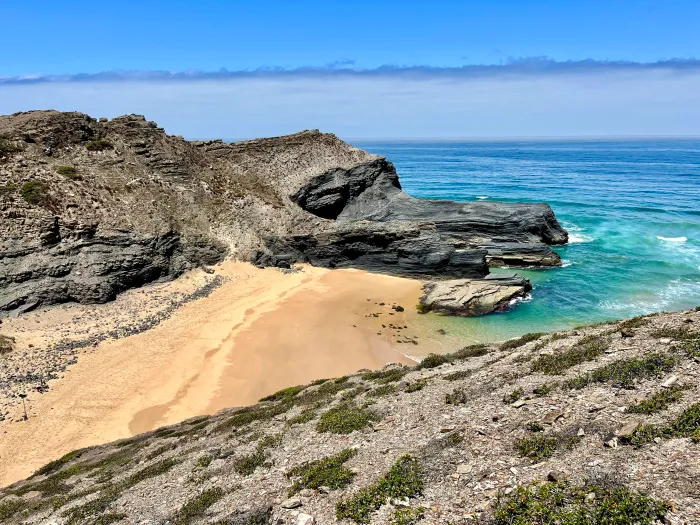
The final day began with a lump in our throats. Leaving Vila do Bispo, we set off on the 21 km hike to Sagres, our last destination. It was a bittersweet moment—a mix of happiness at completing the journey and sadness at knowing it was coming to an end. But the trail didn’t disappoint. Once again, it felt as though we’d entered a completely new landscape. Red stones and black volcanic ashes, approximately 145 to 200 million years old, contrasted beautifully with the deep, endless blue of the ocean.
After more than 170 kilometers, we finally reached Cabo de São Vicente, also known as the Red Lighthouse. The scaffolding around the lighthouse was a huge contrast of everything we experienced along the trail.
This journey had been one of the most rewarding experiences of our lives. It challenged us physically and mentally, forcing us to face the heat of the burning sun, the ankles deep in the sand, and the never-ending dirt roads. Our feet were marked with the challenges it faced along the trail. Looking back, I regretted not having the chance to spend a full day catching the waves on one of the remote beaches.
But more than anything, this trail showed us what it means to meet your limits—and push past them. It was worth every blister, every struggle, every doubt. The Fisherman’s Trail truly is one of the most stunning coastal trails we’ve ever walked, and its memories continue to find their way back to us.
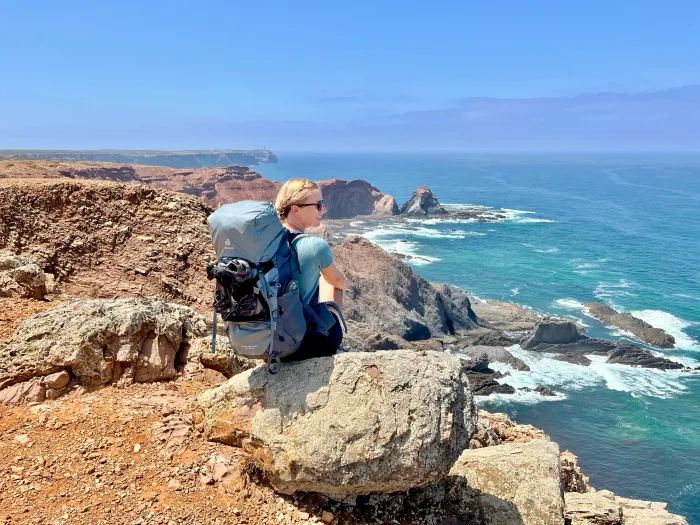
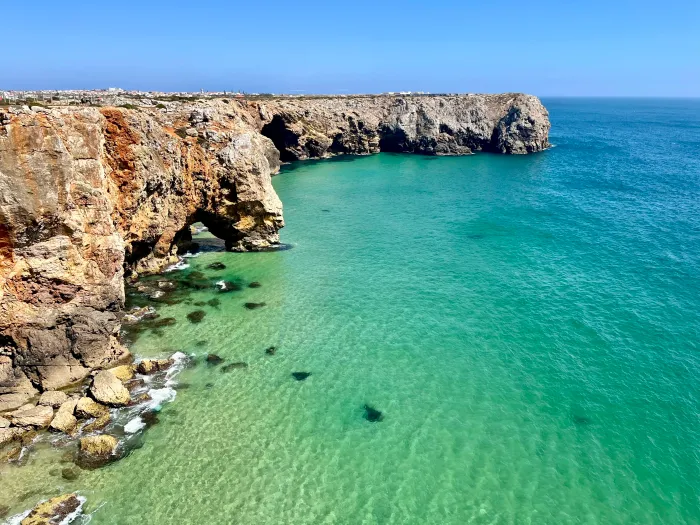
Fisherman’s Trail GPX files
Download the GPX files from the Fisherman’s Trail here! These files are checked and validated on 19 December 2024.
| Stage | File Download |
|---|---|
| Stage 0 | From Sines to Porto Covo |
| Stage 1 | From Porto Covo to Vila Nova de Milfontes |
| Stage 2 | From Vila Nova de Milfontes to Almograve |
| Stage 3 | From Almograve to Zambujeira do Mar |
| Stage 4 | From Zambujeira do Mar to Odeceixe |
| Stage 5 | From Odeceixe to Aljezur |
| Stage 6 | From Aljezur to Arrifana |
| Stage 7 | From Arrifana to Carrapateira |
| Stage 8 | From Carrapateira to Vila do Bispo |
| Stage 9 | From Vila do Bispo to Sagres |
| Stage 10 | From Sagres to Salema |
| Stage 11/12 | From Salema to Lagos |